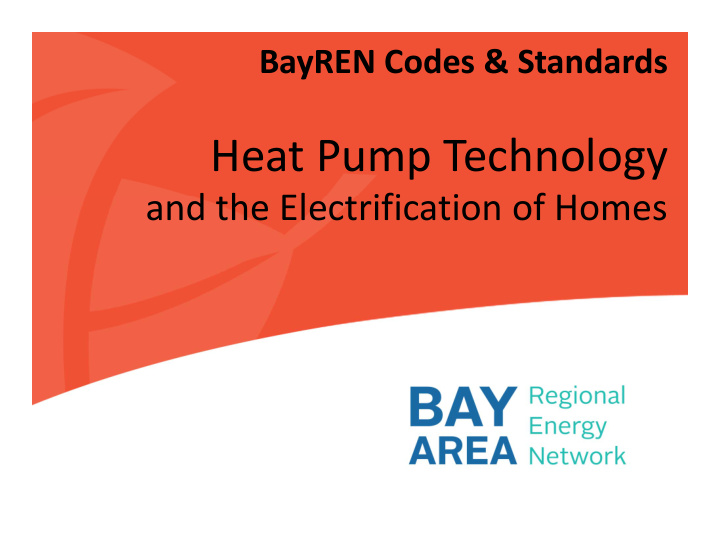



BayREN Codes & Standards Heat Pump Technology and the Electrification of Homes Date
Heat Pump Technology The Title 24, Part 6, Energy Code must consider the economic aspects (costs) of energy consumption. Electricity and gas can both be converted to Btu units for comparison. Electricity, on a Btu‐by‐Btu basis is more expensive than gas. (~3x) This is reflected in a “source energy multiplier” in the energy code compliance calculations. 1
Heat Pump Technology “Efficiency” of a heater is a measure of what you get out (heat) vs. what you put in (gas or electricity). Btus out / Btus in = efficiency It does not consider cost. Even though electric resistance heaters, for example, are more efficient than gas heaters they cost much more to operate. 2
Heat Pump Technology Electric resistance heaters are close to 100% efficient. Essentially all of the electricity consumed is converted to heat. Heat pump efficiencies are generally 2 to 3 times as efficient as a conventional electric resistance heaters. Efficiencies > 100%! How can this be? 3
Heat Pump Technology Realize that: Gas creates Btus when it is burned. Electric resistance creates Btus by passing current through an element. Heat pumps don’t create heat. They just move it from one place to another 4
Heat Pump Technology Everything in the world has some Btus in it. The warmer an object is, the more “dense” the Btus are and the easier they are to extract. Cooling and object is the act of removing Btus. Heating an object is the act of adding Btus. 5
Heat Pump Technology Principle #1 Heat will move from a warmer object or fluid to a cooler object or fluid. Source: HVAC 1.0 – Introduction to Residential HVAC Systems. 6
Heat Pump Technology Principle #2 When you compress a fixed volume of gas, it gets warmer. Source: HVAC 1.0 – Introduction to 7 Residential HVAC Systems.
Heat Pump Technology If you combine Principle #1 and Principle #2, you can cause heat to flow into and out of a gas by compressing and expanding it. Source: HVAC 1.0 – Introduction to Residential 8 HVAC Systems.
Heat Pump Technology The gas is essentially acting like a “heat sponge”. When you expand the sponge, water is absorbed. When you squeeze a sponge water comes out. Source: HVAC 1.0 – Introduction to Residential HVAC Systems. 9
Heat Pump Technology You can use sponges to “pump” water from a lower level to a higher level by squeezing it in one place and expanding it in another. 10 Source: HVAC 1.0 – Introduction to Residential HVAC Systems.
Heat Pump Technology Source: HVAC 1.0 – Introduction to Residential HVAC Systems. 11
Heat Pump Technology Heat pump space heating has been around for a while. It is basically an air conditioner that runs backwards in the winter time. Heat pump water heaters are fairly new, in terms of market availability. Until recently “electric water heater” meant resistance electric water heater. The very high efficiencies of HPWH makes them comparable to gas 12
Heat Pump Technology Typical energy factors (EF) of new water heaters: Gas storage 0.59 to 0.69+ Gas tankless 0.82 to 0.95 Electric resistance storage 0.99 Source: SMUD Heat Pump Water Heater Training 13
Heat Pump Technology Typical energy factors (EF) of new water heaters: Gas storage 0.59 to 0.69+ Gas tankless 0.82 to 0.95 Electric resistance storage 0.99 Heat pump storage 2.00 to 3.40+ Heat pump water heaters are very competitive to gas water heaters plus have many other advantages. Especially when considering time of use electricity rates. Now there is a cost effective electric alternative for water heating. 14 Source: SMUD Heat Pump Water Heater Training
Heat Pump Technology Advantages Environmentally Friendly No fossil fuel (fracking, drilling, pipelines, etc.) No CO or CO 2 is generated by the equipment Can be powered by renewable energy Safety No gas lines = No gas leaks No venting needed, no roof penetrations No Carbon Monoxide (CO) risks No flame ‐ no explosion potential 15 Source: SMUD Heat Pump Water Heater Training
Heat Pump Technology Disadvantages First cost. They are more expensive than other water heaters. First hour delivery – generally considered slower to heat depending on the selected system. Storage tank capacities are generally larger than conventional to compensate for slower recovery rates. Requires an adequate volume of air and special clearances. Location is very important. Source: SMUD Heat Pump Water Heater Training 16
Heat Pump Technology Here is an example of costs from major “big box” store: Energy Factor >3.0 Family size : 4 – 6 240 Volts Add installation charges & other costs 17
Heat Pump Technology Selling points Capitalize on a growing market share driven by: Improved technology A growing consumer awareness and demand The constant move towards energy efficiency Doing your part to help reduce carbon footprint The “Nerd Factor” Source: SMUD Heat Pump Water Heater Training 18
Heat Pump Technology Questions? 19
Recommend
More recommend